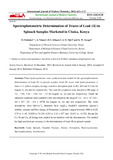| dc.description.abstract | Three hydroxytriazenes were synthesized and studied for the spectrophotometric determination of Lead (II) in spinach samples. Lead (II) reacts with hydroxytriazenes to form a 1:2 yellow complex, having a sensitive absorption peak at 403, 403 and 413 nm for reagent (i), (ii) and (iii) respectively. The Lead (II) complexes were detected at PH range of 7.4 – 7.85, 7.20 – 7.50, 7.0 – 7.5 for reagent (i), (ii) and (iii) respectively. Under the optimum conditions Beer-Lambert’s law was obeyed in the range of 0.8 – 4.8 x 10-5, 0.8 – 4.8 x 10-5, 1.0 – 6.0 x 10-5M for reagent (i), (ii) and (iii) respectively. The molar absorptivity (moL-1dm3cm-1), detection limit (mg/L), Sandell’s sensitivity (ng/cm3), stability constant and Free energy of Formation (kcal/moL) ranged between 3900 to 6125, 5.75 to 11.45, 33.829 to 53.129, 0.282 to 2.12 x 1010 and -12.671 to -13.522. Except Zn, Co, Ni and Cu, all foreign ions studied do not interfere with the determination. The method has high precision and accuracy in the determination of Lead (II) in spinach sample. | en_US |

